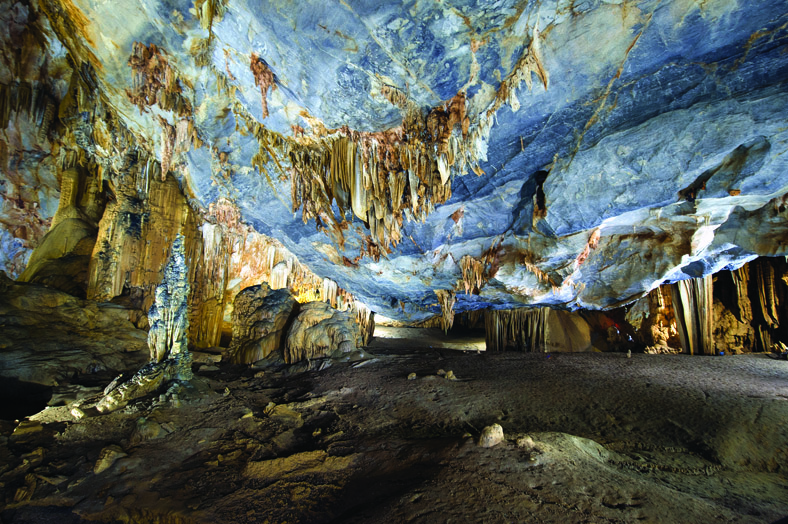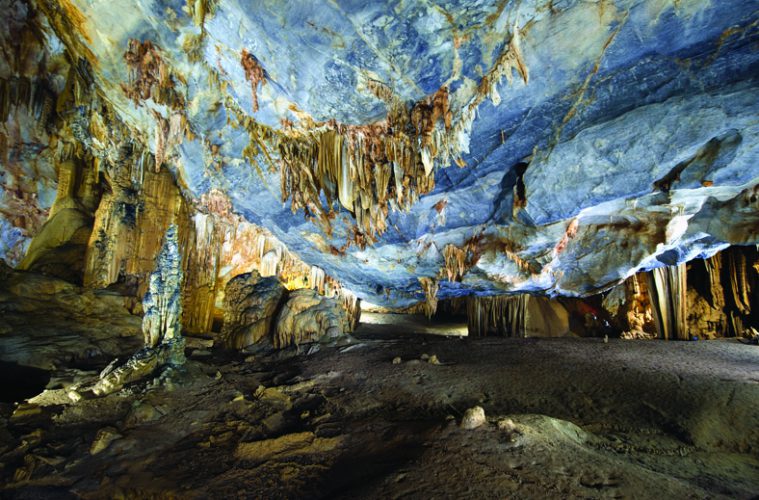BY PIP DE ROUVRAY
(No.6, Vol.6,Aug-Sep 2016 Vietnam Heritage Magazine)




Photos: Hoang Trung Thuy
Are you an armchair traveller? Are you one of those who enjoy reading about places far away from the comfort of your own living room? Maybe it is just out of curiosity or maybe constraints of finance, health and/or age prevent you from going to certain destinations. Well, if that is the case, you probably would be interested in at least a peek at Hoang Trung Thuy’s photo album, ‘Dong Thien Duong’ (‘A Story of Paradise Cave’). I must confess that I picked it up as much out of nostalgia as to learn about somewhere new. In the late nineties, I lived in Quang Binh Province where this cave is located. It had been discovered by 1992, but it was generally unknown by and certainly not open to the public. I did, however, have the wonderful experience of visiting the Phong Nha (Wind Fang) underground river and seeing the stalactites and stalagmites by hopping off the boat and walking around its banks. On my second trip, they had enhanced the place by adding coloured lighting. So this book naturally intrigued me.
Discovered after my time in Quang Binh, the reader may have seen spectacular pictures in such magazines as ‘National Geographic’ of Son Doong cave system nearby. This costs three thousand dollars for a five-day visit and requires you to be strenuously fit, as a lot of hard hiking is involved. The entry ticket to this cave system, in contrast, is modestly priced and you can drive right up to top of the mountain. Indeed, the first pictures in the book are of the car park and entrance with its restaurant. Electric buggies to take you to the mouth are also shown, as well as the path and beginning of a wooden staircase for those who prefer to walk. This staircase which is 3.5 metres in width and a 1.1 kilometre long, holds the national record for ‘longest wooden path’.
The first main section of the book shows a series of cavern areas with strange and beautiful rock formations. The cave is classified as ‘dry,’ but depending on the time of year, you will come across shallow steams and even lakes. There are sections devoted to stalactites and stalagmites. These amazing creations of nature can take forms familiar in local culture such as female Buddha, houses on stilts, rice terraces and animals such as rabbits and birds.
One great thing about this book is that it explains in few and simple words the geology behind these beautiful rocks. We have all heard of stalactites and stalagmites; some might even know the former hang vertically down while the latter build up from the ground. Who though has heard of rimstone, flowstone and travertine? There is a whole section on rimstone which is a rock form that looks similar to octopus tentacles.
The photographer also draws our attention to the sediment floor and the patterns formed on it. He has shots of natural paving and spongiform rocks. You may walk on dry ground, but we are reminded in the pictures that a river must have flown there for millions of years. Those rounded pebbles some as big as golf balls could only have been formed by eons of water flow.
Thuy does not let us forget about the creepy crawlers that inhabit the cave. It is not just the bats and moths. Also caught by the camera’s eye are beetles, ants worms, scorpions, shrimp and tiny fish. He has not left out the flora either; mosses, algae and lichens. He even discovered a 15-centimeter tree growing horizontally in a dark corner 300 metres way from a shaft of light with green leaves and a white trunk stuck on the edge of a humid stalactite.
The author details the challenges he faced in producing this photo collection. He acknowledges it could not have been achieved without the good co-operation of the Board of Management of Paradise Cave. He also undertook the project with a team of other photographers. It took several visits over two years to accomplish the task. This was due to the difficulties of terrain and to the fact they wished to portray the contrast in the nature of the cave in the wet and dry seasons. On the first trip, they were able to do little more than a topographical survey, as they realised they had inadequate lighting. They upgraded both the quantity of lights and the power of lighting and returned. A further expedition of five days was undertaken in the rainy season. Their mobility was restricted and three of the group of seven gave up on the first day. They were only able to penetrate four kilometers of a system of over thirty, due to water reaching the top of the cave at this point.
Well, we all thought Paradise was in the sky. Here, it seems, it is located where Hell ought to be. Thuy shows us that the Creator does work wondrously underground. It certainly a delightful tome to have on your lap and flick through. If you are reading this on your deckchair by your hotel’s pool, you may be inspired to put Paradise Cave on your tourist itinerary. When I visited a Quang Binh cave years ago, there were no hotels and very little in the way of tourist infrastructure. Neither were there flights to nearby Dong Hoi Airport. It is a very different story now. Thuy’s excellent tome is enough to make me want to get put of my armchair and make a return trip to the area!


